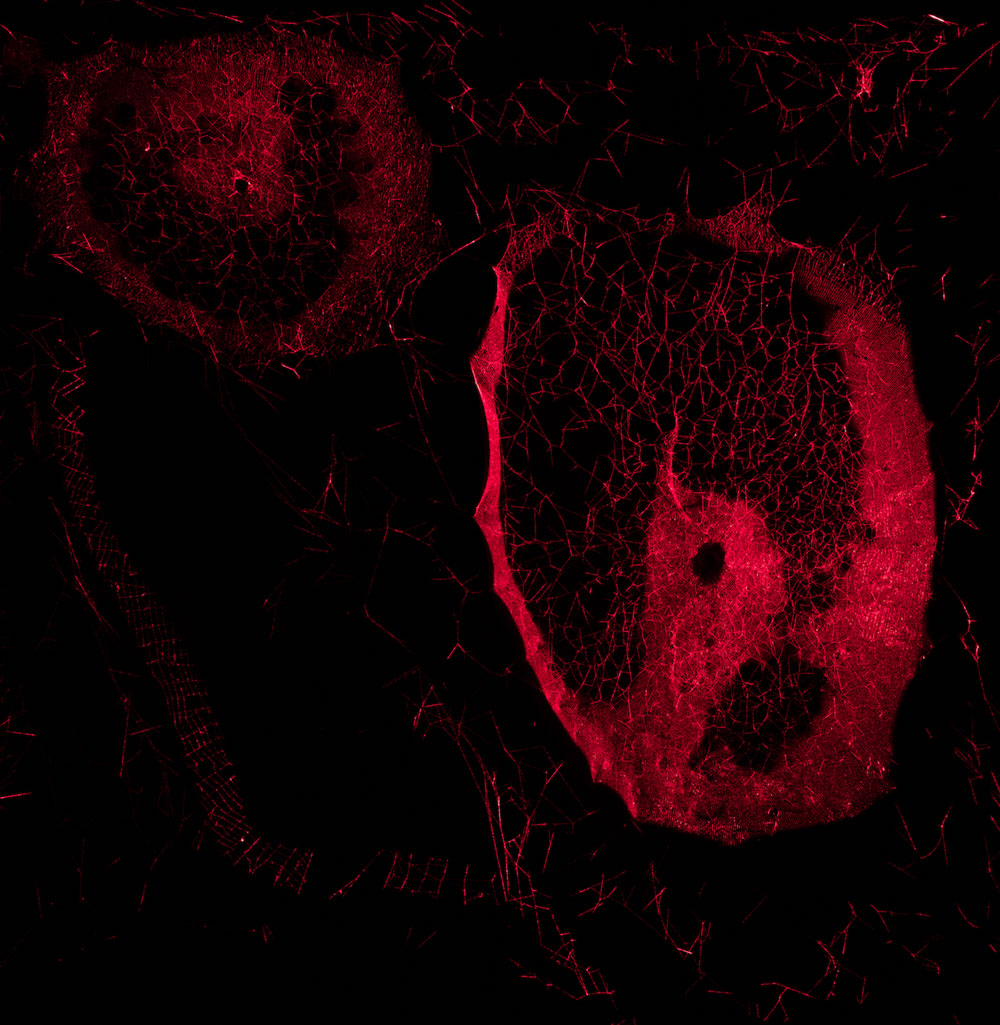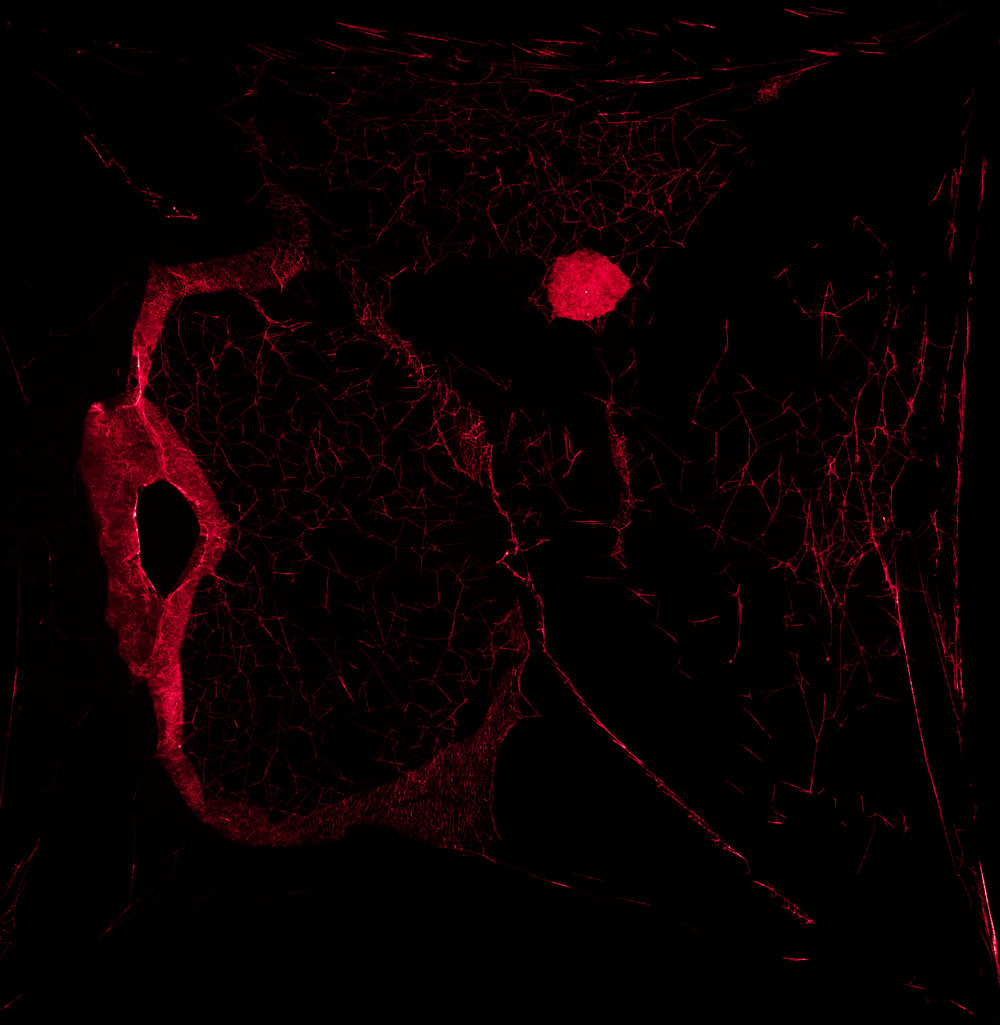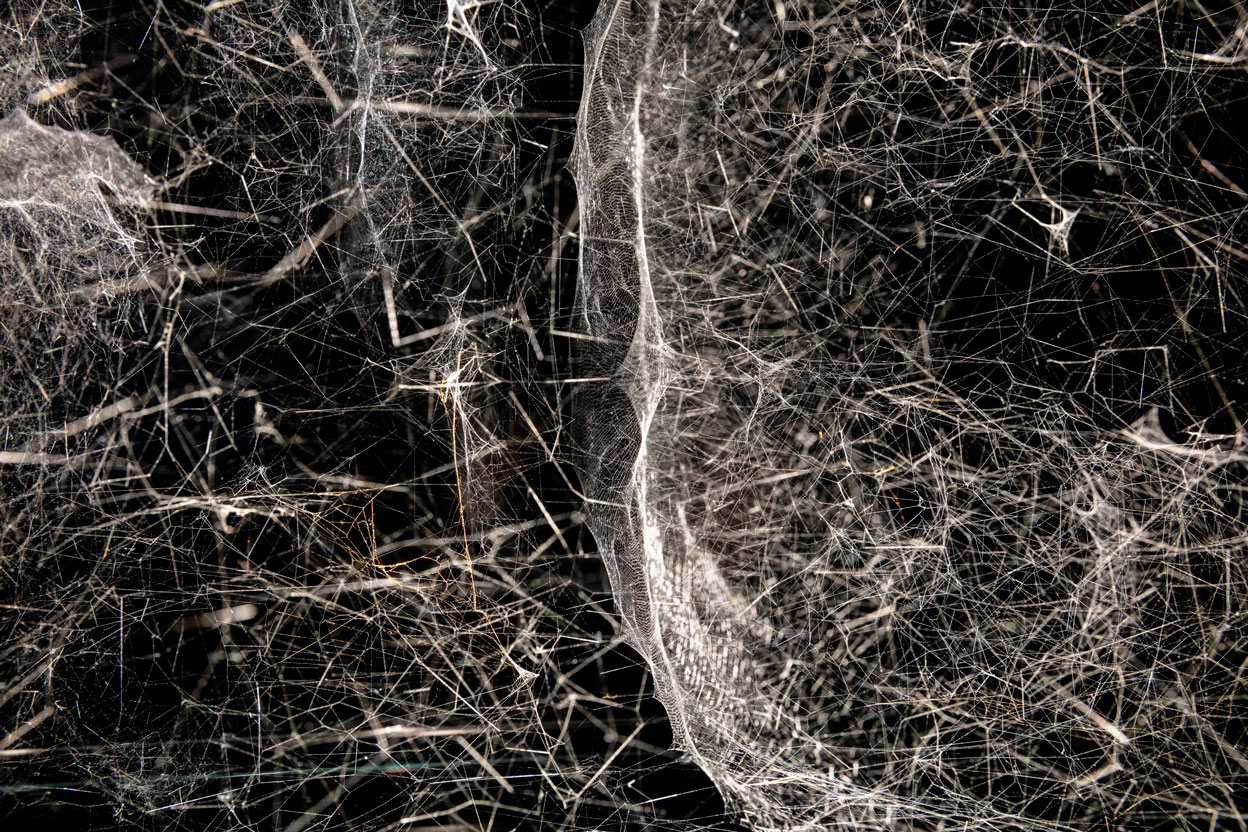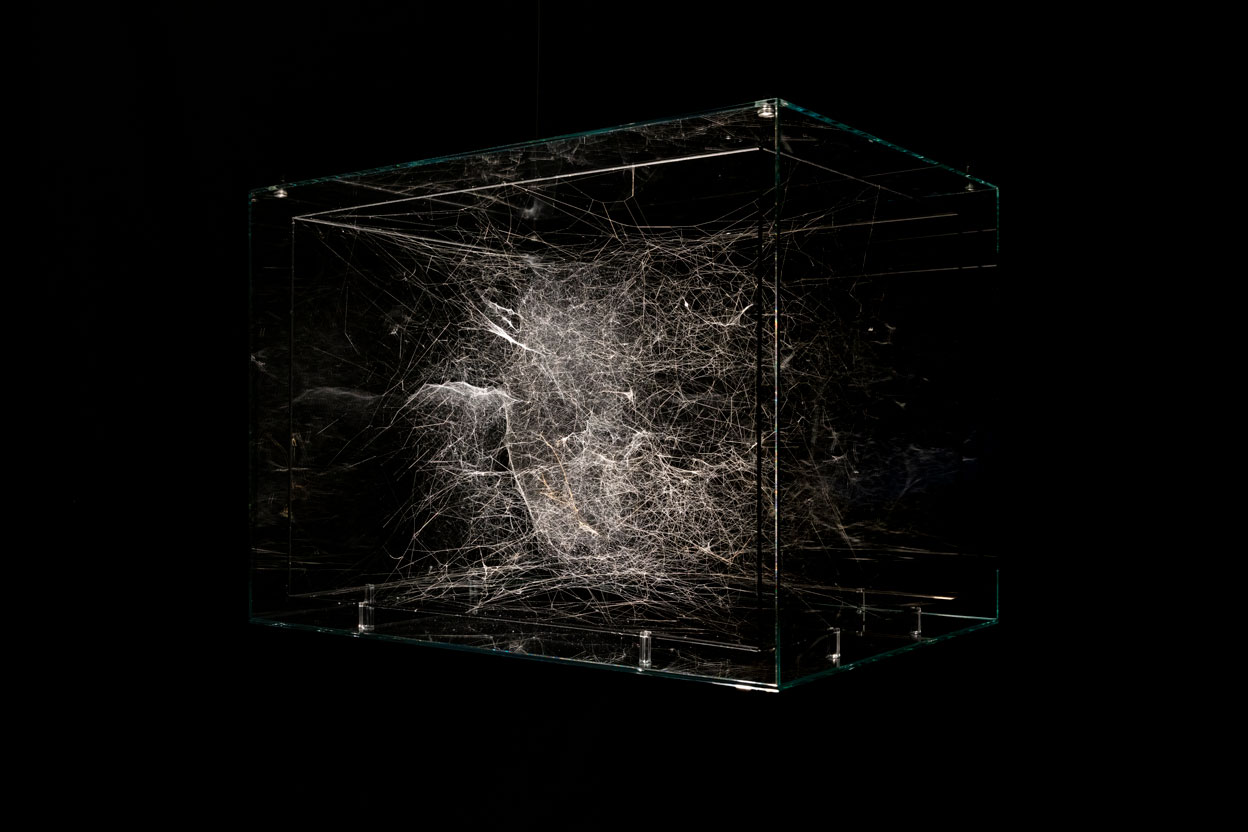ART-PRESENTATION: More Than Humans
 The exhibition “More-than-humans” brings together, Dominique Gonzalez-Foerster and Tomás Saraceno, their work is inspired by research yet transcends modes of knowing intellectually, considering that which cannot be explained by the rational anthropoid mind. The exhibition invites visitors to explore questions of human and nonhuman technologies, culture in the Anthropocene, our own intelligence and that of other species, haunted presences at the edge of disappearance, and the power and attraction of the unknown.
The exhibition “More-than-humans” brings together, Dominique Gonzalez-Foerster and Tomás Saraceno, their work is inspired by research yet transcends modes of knowing intellectually, considering that which cannot be explained by the rational anthropoid mind. The exhibition invites visitors to explore questions of human and nonhuman technologies, culture in the Anthropocene, our own intelligence and that of other species, haunted presences at the edge of disappearance, and the power and attraction of the unknown.
By Efi Michalarou
Photo: TBA 21 Archive
Dominique Gonzalez-Foerster searches for what exists behind images and visual experiences. Her work is inspired by modernism, architecture, literature, and cinema, and yet she is less interested in narrative than in the pleasure of the image’s atmosphere. 19th Century photography is a recurring source of inspiration, as artists often used it in search of the uncanny or supernatural. “Opera (QM.15)” (2016) draws on early holographic techniques—speculative simulacra conflating different temporal ind spatial dimensions. In the work Gonzalez-Foerster appears as the soprano Maria Callas (1923–1977), dressed in the iconic red garments of her last performances while lip-syncing to some of her most famous early recordings. Callas is one of a series of personalities, including the actresses Marilyn Monroe and Sarah Bernhardt, who appear in installations that Gonzalez-Foerster refers to as “apparitions” as if they were, in the words of the artist, “a kind of spiritual session”. The letters QM in the title are inspired by Bernhardt’s maxim “quand mκme” which translates as “even so” or “nevertheless”. To Gonzalez-Foerster, the expression resonates with the lives of the personas she appears as: “They can’t stop, and art is their vehicle; their very lives must become works of art, no matter the cost. The supreme excitement is the artistic experience”. Throughout their lives, Bernhardt, Callas, and Monroe had to shield their private lives against public interest. Living for their passion (their art) their lives were prone to drama. Numerous rumored love affairs contributed to the enigma surrounding them. As women they had to negotiate expectations placed on them, which in the case of Monroe famously led to her death by suicide at age 36. Callas similarly passed under mysterious circumstances, and Bernhardt was fascinated by death throughout her life. When she played death scenes on the stage, audiences were often in tears, contributing to her prominence but also to the mystery of her persona and her legacy. The three women’s passion for art and their uncompromising ways of living their lives, as well as a fascination with the otherworldly, the haunted, and the thin line between this and other worlds, crystallize in Gonzalez Foerster’s “QM” series, including “Opera (QM.15)”, on view in this exhibition.he performances function as what the psychoanalyst Donald Woods Winnicott calls transitional objects, a bridge between the real world and the world of the imagination. Psycho-sensitive as they are, they may activate unconscious feelings and memories. Tomαs Saraceno is known for his speculative research projects, such as “Aerocene”, an interdisciplinary artistic inquiry into alternative modes of transportation that do not require fossil fuels, and for his collaborations with spiders. The Arachnophilia Team at his studio homes in on lively multispecies ecologies, cultivating different “arts of noticing,” a phrase coined by the anthropologist Anna Lowenhaupt Tsing. Collaborators from various disciplines, from arachnologists to entomologists to ethologists to geographers, come together to explore complex forms of spider architecture or culture, together with the spiders and through different socialities. In workshops and discussions organized on the occasion of his exhibitions, Saraceno has invited collaborators to explore areas such as biotremology (the vibrations produced, dispersed, and perceived by spiders) and develops playful ways of encountering webs by readings conducted with his Arachnomancy divination cards. This take on tarot cards formed part of his “Spider/Web Pavilion 7” at the 2019 Venice Biennale. These readings propose a non-anthropocentric way of storytelling involving practitioners from different fields, who interpret the structure and vibrations of a spider/ web. Drawing on age-old forms of storytelling that resonate with cultural, spiritual, and scientific realms, these readings highlight the interwoven histories, presents, and futures of humans, spiders, and other species. The Western trope of human exceptionalism and agency set apart from our interactions with other beings is here undone for speculative interpretation of how our shared ecologies might play out in the Chthulucene. The feminist theorist Donna Haraway has proposed this term as an alternative way of conceptualizing our current epoch, describing it as a time when the (Western) Anthropos ceases to be a destructive force on the planet and acknowledges and enjoys its kinship with many other forms of life and nonlife. The works on paper “Solitary semi-social mapping of HS 1700+6416 by a solo Nephila senegalensis—one week and a solo Cyrtophora citricola—three weeks” (2016) and “Solitary semi-social mapping of Ceginus by a duet of Nephila senegalensis—four weeks, a triplet of Cyrtophora citricola—three Weeks” (2018) were each made in collaboration with two different spider species. In bringing together genera that would not normally collaborate, Saraceno, his studio, and their spider collaborators bring forth hybrid spider/webs created in multispecies gatherings. The series of Spider/Web prints offer a different way to read and interpret the architecture of the spider/ web: as a topological map of movements and temporalities that trace the intricate complexities of these silken sculptures. The installations “Hybrid semi-social solitary Instrument HD74874 built by a triplet of Cyrtophora citricola—four weeks—and a solo Angelena labyrinthyca—one week” (2019) and “How to entangle the universe in a spider web?” (2018) forms part of Saraceno’s celebrated studies of spider/webs, whose complex structures resemble tiny universes, surpassing many of the architectural and other constructions made by humans, resonating across scales with the cosmic web. Some scientists have observed that complex, three-dimensional spider/webs resemble computer simulations of the cosmic web. In the second installation, a laser sheet bidimensionally intersects the spider/web. The visual vibratory signals of the laser reveal the hidden architectural entanglements woven by the spiders. In other works Saraceno amplifies the vibrations of spider/webs as if they were musical instruments, making them audible for human participants. Webs and networks are a ubiquitous reference in culture today, and yet the spiders’ complex webs and lifeworld still seem alien to us. The video “Living at the bottom of the ocean of air (Underwater spider)” (2018) focuses on a particularly curious arachnid, the diving bell spider (Argyroneta aquatica), a species that lives almost entirely underwater in lakes, ponds, and marshes. Surrounding its abdomen is an air bubble captured with its hairs and giving it a silvery appearance. The spider surfaces only briefly to replenish its air supplies. Underwater it resides in its air bell, dashing at prey that touch the silk threads attaching it to plants. This unique behavior highlights the capacity of certain species to transform their way of life to adapt to new environments. In this way the underwater spider sounds an invitation for biospeculation, calling us to question the unexplored possibilities of our future environment.
Info: Curator: Stefanie Hessler, Museo Nacional Thyssen-Bornemisza, Paseo del Prado 8, Madrid, Duration 25/9-1/1/19, Days & Hours: Mon 12:00-16:00, Tue-Sun 10:00-19:00, www.museothyssen.org





![Tomás Saraceno, Living at the Bottom of the Ocean of Air (Underwater Spider) [Video still], 2018, Single-channel video, b/w, stereo sound, Duration 9’ 10’’, Courtesy the artist | Tanya Bonakdar Gallery-New York; Ruth Benzacar-Buenos Aires; Andersen’s Contemporary-Copenhagen; Pinksummer Contemporary Art-Genoa; Esther Shipper-Berlin, Thyssen-Bornemisza Art Contemporary Collection](http://www.dreamideamachine.com/web/wp-content/uploads/2019/09/Toms-Saraceno-Living-at-the-Bottom-3.jpg)
![Tomás Saraceno, Living at the Bottom of the Ocean of Air (Underwater Spider) [Video still], 2018, Single-channel video, b/w, stereo sound, Duration 9’ 10’’, Courtesy the artist | Tanya Bonakdar Gallery-New York; Ruth Benzacar-Buenos Aires; Andersen’s Contemporary-Copenhagen; Pinksummer Contemporary Art-Genoa; Esther Shipper-Berlin, Thyssen-Bornemisza Art Contemporary Collection](http://www.dreamideamachine.com/web/wp-content/uploads/2019/09/Toms-Saraceno-Living-at-the-Bottom-4.jpg)
![Tomás Saraceno, Living at the Bottom of the Ocean of Air (Underwater Spider) [Video still], 2018, Single-channel video, b/w, stereo sound, Duration 9’ 10’’, Courtesy the artist | Tanya Bonakdar Gallery-New York; Ruth Benzacar-Buenos Aires; Andersen’s Contemporary-Copenhagen; Pinksummer Contemporary Art-Genoa; Esther Shipper-Berlin, Thyssen-Bornemisza Art Contemporary Collection](http://www.dreamideamachine.com/web/wp-content/uploads/2019/09/Toms-Saraceno-Living-at-the-Bottom-5.jpg)
